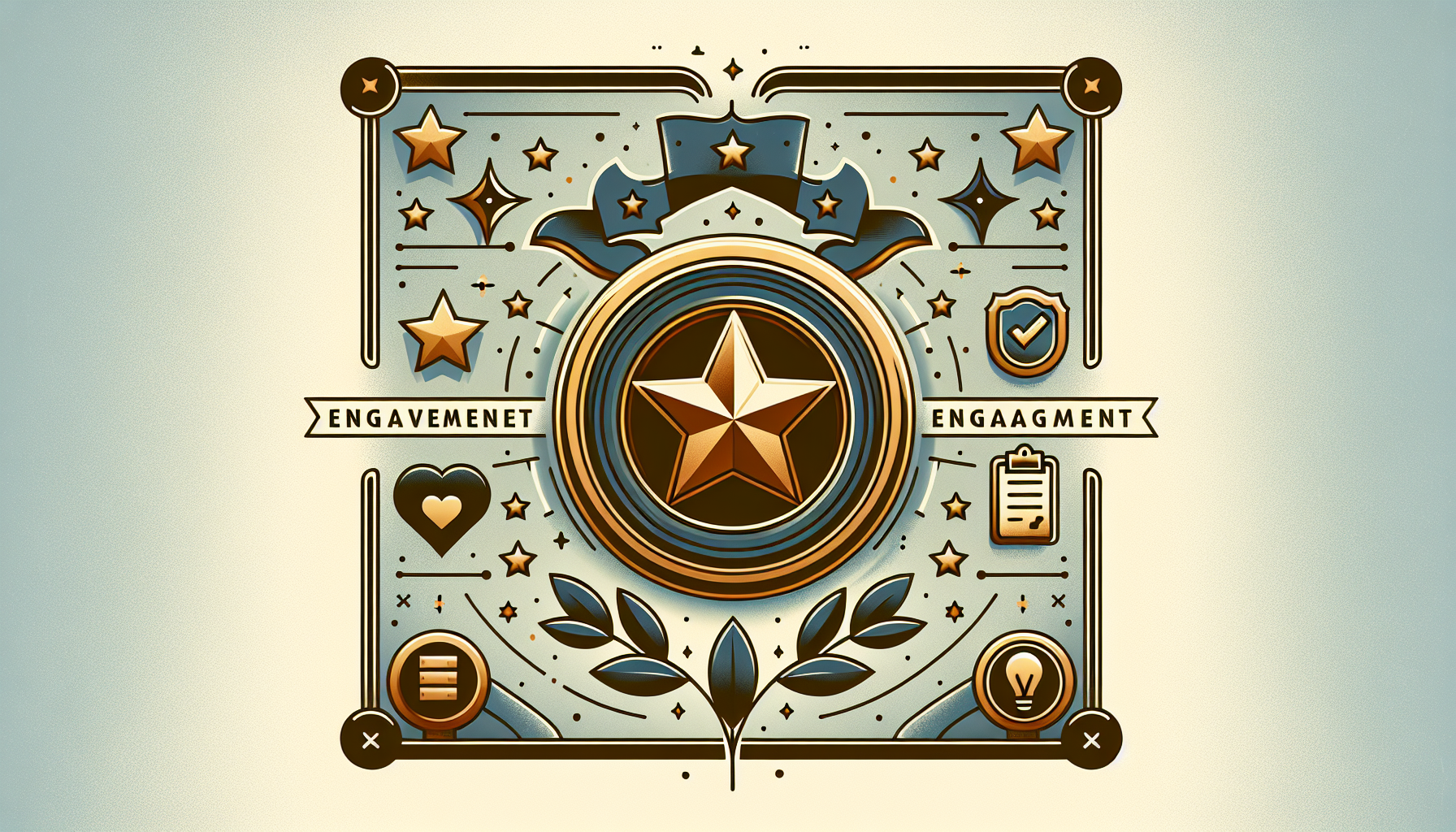Are you struggling to keep your audience engaged? You’re not alone—many communities and organizations face the challenge of capturing attention and maintaining interest. Badges and rewards are powerful tools that can turn that around and inject some fun into your engagement strategies.
Stick around, and I’ll share insights on how badges and rewards can motivate your audience and foster a sense of achievement. By the end, you’ll be equipped with creative ideas and practical tips to make your engagement efforts truly shine.
We’ll explore what badges and rewards are, design effective systems, and look at successful examples, plus some pitfalls to avoid. Get ready to level up your engagement game!
Key Takeaways
- Use badges and rewards to enhance engagement and recognition among your audience.
- Badges symbolize achievements, while rewards provide immediate gratification.
- Ensure badges align with specific behaviors or milestones to motivate participation.
- Design visually appealing badges and provide feedback to deepen the meaning behind them.
- Implement a clear rewards system that resonates with your audience for maximum impact.
- Measure effectiveness through analytics and student feedback to continuously improve your system.
- Engage students in the design process and keep your badge system diverse and relevant.

Using Badges and Rewards to Boost Engagement
Incorporating badges and rewards into your learning environment can transform student engagement. They tap into our natural desire for recognition and achievement. When students earn a badge for their hard work or get rewarded for completing tasks, it boosts their motivation and sense of accomplishment.
But what makes badges and rewards so effective? They create a clear pathway for students, showing them exactly what they can achieve. Plus, visual symbols of success—like a shiny badge—can serve as powerful reminders of their progress.
Understanding Badges and Rewards
Badges and rewards are tools often used in educational settings to encourage participation and recognize achievements. A badge is a visual representation of a skill or accomplishment, while rewards can be tangible incentives like gift cards, fun activities, or points that lead to bigger prizes.
Essentially, badges are about acknowledgment and proudly displaying what you’ve done. Rewards, on the other hand, often trigger immediate gratification that can spur further engagement. This combination can create a powerful impact when utilized effectively in learning platforms.
To really drive engagement, it’s important to make sure that the badges and rewards relate clearly to desired behaviors or learning milestones. This alignment ensures that students see the value in what they’re working towards and feel excited about participating.
Types of Badges and Rewards
There are various types of badges and rewards that you can implement in your educational programs. Let’s break them down.
1. **Achievement Badges**: These are awarded for completing a particular task or reaching a specific milestone in the course. For example, completing a module can earn students a ‘Module Master’ badge.
2. **Participation Badges**: These encourage students to engage in classroom discussions or group activities. Recognizing a student who regularly contributes can motivate others to join in.
3. **Skill Badges**: Focused on skill acquisition, these badges signify mastery in a certain area. For instance, a ‘Writing Pro’ badge can be awarded after completing a writing workshop.
4. **Rewards**: Beyond badges, consider implementing a points system. Students can earn points for completing tasks or helping peers, which can later be exchanged for tangible rewards, like school merchandise or extra credit.
Designing an Effective Badge System
Creating a badge system starts with clarity. Define what behaviors, skills, or milestones you want to recognize. Organize these into levels, so students can work towards greater achievements.
Your badge design should also be visually appealing. A well-designed badge not only looks nice but also represents the effort behind earning it. Consider using platforms like Canva to create customized badges that clearly convey their meaning.
Providing students feedback when they earn a badge is crucial. Let them know why they received it and what they can do next. It turns a simple acknowledgment into a learning opportunity.
Lastly, keep the system transparent. Make it easy for students to see what badges are available and how to earn them. A public leaderboard or badge tracker can ignite friendly competition and further engagement.

Implementing Rewards to Drive Engagement
To truly harness the power of rewards, it’s crucial to implement them strategically within your program.
Start by clearly defining what actions or milestones will trigger a reward. This could range from completing a module to actively participating in discussions. The clearer these expectations are, the more motivated students will be.
Next, consider the types of rewards that will resonate most with your audience. Monetary rewards like gift cards can work wonders, but sometimes, smaller acknowledgments like extra credit or free time can be just as effective.
Don’t forget to promote your rewards system actively. Let students know what’s up for grabs and how they can earn it. Creating a buzz around your rewards can increase participation and excitement.
It’s also key to celebrate achievements publicly, whether through social media shoutouts or classroom announcements. Such recognition not only rewards the individual but also inspires others to strive for similar success.
Finally, keep testing and tweaking your rewards based on student feedback. What works for one group may not work for another. Regularly revisiting this aspect can help maintain enthusiasm.
Measuring the Impact of Badges and Rewards
Measuring the effectiveness of your badges and rewards system is essential to understanding its true impact on student engagement.
One way to track effectiveness is through analytics. Look for trends in participation and completion rates before and after implementing the system.
Surveys can also provide valuable insights. Regularly ask students how they feel about the badges and rewards. Are they finding them motivating? Is the system fair? Their feedback can guide enhancements.
Another approach is to set specific goals related to engagement metrics, such as increasing participation by a certain percentage. Use these metrics as benchmarks for success.
Don’t forget qualitative data, too. Gather stories or testimonials from students about how earning a badge or reward made a difference in their experience. This can provide a rich narrative to complement the numbers.
Lastly, consider conducting A/B testing. Try different approaches in similar groups and compare the results. This smart tactic can showcase what methods work best.
Best Practices for Using Badges and Rewards
When it comes to using badges and rewards effectively, a few best practices can ensure you get the most impact.
First off, align badges and rewards directly with learning outcomes. Make sure they encourage behaviors that lead to achieving academic goals.
Secondly, keep the badge system diverse. Offer various badges for different activities to appeal to different student interests and strengths.
Involve students in the creation process. Their input can lead to a more engaging and relevant system, where they feel ownership over their achievements.
Use storytelling to your advantage. Create a narrative around the badges that resonates with students. For example, students might embark on a “quest” to earn badges, making the experience more engaging.
Last but not least, regularly review the effectiveness of your system. Stay attuned to student responses and be willing to adapt the program to improve motivation and engagement over time.
Examples of Successful Badge and Reward Programs
Seeing real-world examples can spark inspiration for your own badge and reward systems.
One compelling case is the Coursera platform. They offer badges upon course completion, which students can showcase on social media or linked accounts. This not only recognizes achievement but also encourages students to share their successes.
Another great example comes from Codecademy, where learners earn badges for mastering different coding languages and completing projects. This instant feedback drives continued engagement as learners can track their skill development visually.
Lastly, the Khan Academy has implemented a robust system of badges and energy points. Students earn points for watching videos and completing exercises, promoting a sense of achievement and motivating them to push further.
These programs demonstrate that when designed thoughtfully,
badges and rewards can cultivate a thriving community of learners eager to engage. Each of these examples highlights the balance between recognition and intrinsic motivation that keeps students coming back for more.

Pitfalls to Avoid When Using Badges and Rewards
While badges and rewards can enhance student engagement, there are some traps you should avoid to ensure your system is effective.
First up, don’t overcomplicate the badge criteria. If students feel confused about how to earn badges, they might lose interest. Keep it straightforward.
Another pitfall is the risk of demotivation. If students see peers earning rewards without putting in the effort, it can lead to frustration. Ensure that your system is fair and that rewards are tied to genuine achievements.
Watch out for the “once-and-done” approach. Implement your badges and rewards, but then forget about them. Regularly review and update your system to keep it fresh and aligned with student interests.
Also, avoid using rewards that are too far removed from the learning experience. For instance, giving out large prizes for trivial tasks can undermine the educational value of the badges.
Finally, don’t neglect to communicate. Keep students informed about the rewards available and how they can earn them. A lack of awareness can lead to disengagement.
Measuring the Impact of Badges and Rewards
You can track the success of your badges and rewards system through several insightful methods.
One effective way is to use data analytics. Look at participation rates and completion statistics before and after implementing the system.
Gather feedback through student surveys. Ask them directly if they find the badges and rewards motivating and if they feel that the criteria are fair.
Also, set clear objectives that can be measured. Aim for specific improvements in engagement or performance metrics and use these as a success gauge.
Another useful tactic is to collect anecdotal evidence. Listen to student stories about how earning a badge influenced their learning journey.
Conduct A/B testing regularly. Experiment with different badge designs or reward types to see which ones resonate best with your audience.
FAQs
Badges and rewards are incentives used to motivate users and enhance engagement. Badges signify achievements, while rewards can be tangible or intangible benefits that recognize user participation and effort in a specific platform or community.
An effective badge system should be user-friendly, aligned with goals, and visually appealing. It should define clear criteria for earning badges and encourage participation by showcasing users’ achievements prominently.
Common pitfalls include over-complicating the criteria for earning badges, undervaluing rewards, and failing to regularly update the system. It’s crucial to maintain balance so that badges and rewards remain motivating rather than frustrating.
Measuring impact can be done through user metrics like participation rates, engagement levels, and retention statistics. Surveys and user feedback also provide valuable insights into the effectiveness of badges and reward systems.
